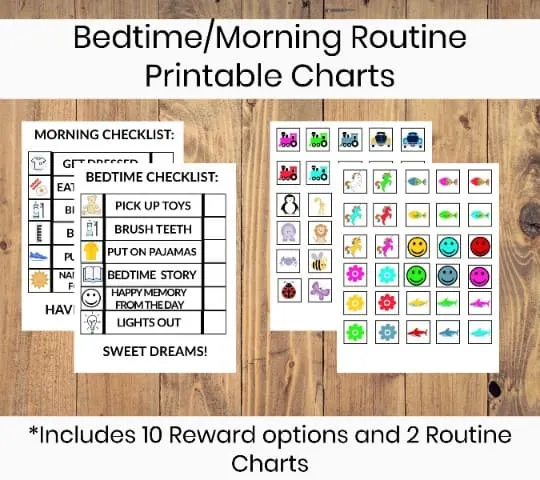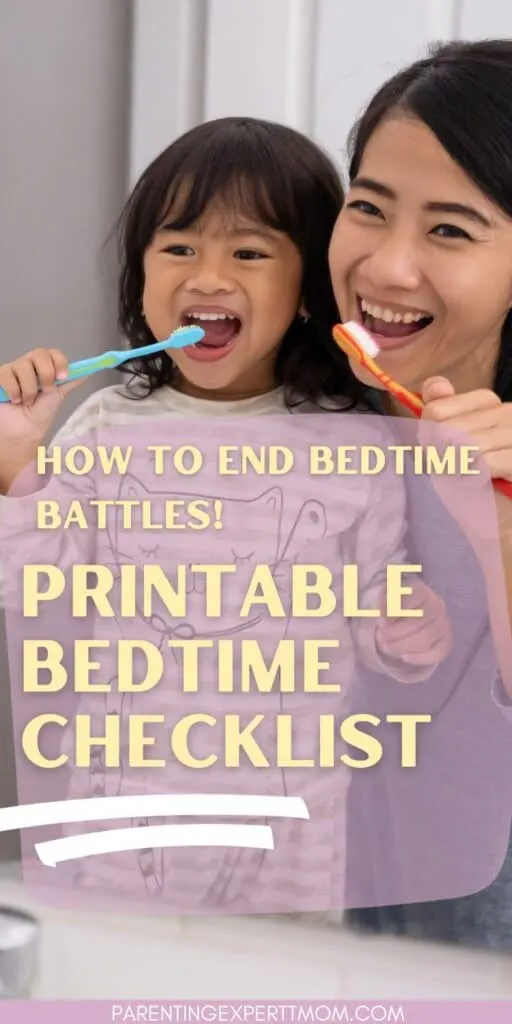Is your Bedtime Routine Stressful?
A peaceful bedtime can feel like a distant dream for parents of little kids.
However, a structured bedtime routine can be a game-changer, and a bedtime routine chart can be a great way to bring calm to the chaos.
By using visual cues to guide your child through their pre-sleep tasks, you’re not only fostering independence but also instilling healthy sleep habits.
This blog post will delve into how a printable toddler bedtime checklist can turn bedtime battles into bedtime bliss, making nights less stressful and more restful for everyone in the family.

(This post may contain affiliate links. To read our full disclosure policy click here.)
End the Bedtime Battle
Stepping up your bedtime routine with the use of a toddler bedtime checklist can be an excellent way to streamline the process and foster a sense of stability in your child’s life.
A predictable bedtime routine is essentiall for young children, and a checklist helps ensure consistency.
This routine’s structure provides a sense of security, helping children understand what’s expected of them and what will happen next.
Visual aids such as pictures of a child brushing their teeth or reading a book before bed can serve as cues, guiding your child through their tasks while cementing the routine in their memory.
This makes the process smoother and reduces any resistance or fuss, as they know exactly what to anticipate.
Additionally, these checklists instill healthy habits at an early age.
Children learn the importance of brushing their teeth, washing their faces, and other crucial activities that contribute to their overall health and hygiene.
A bedtime checklist doesn’t just lead to a smoother bedtime – it helps cultivate a routine that promotes better sleep, healthier habits, and a sense of independence.

Getting Your Bedtime Routine Checklist Ready
Creating a bedtime routine checklist can be fun and beneficial for both parents and young children.
The key is to keep it short, simple, and developmentally appropriate.
Remember, young children can’t read yet, so visual reminders are the best way to communicate the tasks.
Start by selecting a few essential tasks that make up your child’s evening routine.
This could include brushing teeth, putting on pajamas, and reading a bedtime story.
Each task should be represented with a simple, clear image that your child can easily understand.
Next, compile these images into a bedtime routine printable, which you can easily design on your computer.
If you’re short on time or resources, don’t worry, I’ve got you covered!
I’ve created a handy printable chart that you can print off HERE.
Once you have your printable, consider laminating the chart or placing it in a sheet protector.
This simple step will ensure the printable lasts longer and can withstand the hands-on interaction with your child.
Now, it’s time to make the checklist interactive.
Velcro dots work great for this purpose.
Stick one side of the Velcro to the chart next to the tasks, and the other side to corresponding pictures.
As your child completes each task, they can attach a “sticker” image to the Velcro dot, physically checking off their tasks and making the bedtime routine a fun way to end their day.
In conclusion, a bedtime routine checklist is more than just a printable chart.
It’s a visual reminder of the steps in their evening routine, a tool for fostering independence, and a fun activity that can make bedtime less stressful and more enjoyable.

Have a Consistent Bedtime Routine
Maintaining a consistent bedtime routine is a critical aspect of avoiding bedtime battles, ensuring a stress-free end to the day for both parents and children.
One of the key factors in a successful bedtime routine is starting before your child reaches the point of exhaustion.
If a child is already too tired, they are more likely to get cranky and resist going to bed, leading to tantrums and other disruptive behaviors.
This is where the child’s routines and routine cards come into the picture.
These tools provide a structured bedtime routine that can be easily followed, incorporating essential tasks such as brushing teeth and story time.
The visual cues from routine cards can gently guide children through the steps of their bedtime routine without feeling rushed or pressured.
The routine cards serve as a visual roadmap, helping children anticipate the next step.
This consistency brings a sense of order and predictability to their daily life. It can also make the transition from wakefulness to sleep smoother, providing a calming effect that aids in falling asleep faster and ensures a good night’s rest.
Establishing a healthy bedtime routine is one of the most important things you can do for your child’s well-being.
Consistency and routine give your child a sense of security and control, reducing bedtime resistance and fostering better sleep habits.
What age can you introduce a bedtime routine checklist?
You can introduce a bedtime routine checklist to your child’s routine from a very early age.
Even before your child can physically check off tasks on their own, the bedtime chart can be employed as an early literacy activity.
As part of their bedtime routine, you can point to each step on the chart and discuss it with your child.
This can be a fun and interactive way to wind down at the end of the day.
For younger kids, the practice of going over the nightly routine together can be an enjoyable bonding time while subtly instilling the sequence of the bedtime routine.
As your child grows and develops, the bedtime chart can morph into a tool for promoting independence.
Older children often enjoy the responsibility of checking off their own tasks, and the consistency of a visual checklist can make the bedtime routine smoother and less stressful for all involved.
Indeed, one of the best ways to instill healthy habits and routines in children is to make them an active part of the process.
Hence, a bedtime routine checklist can be a valuable tool from a very young age and continue to serve its purpose as your child grows.

I Hope Bedtime Goes Smoothly Tonight!
In conclusion, establishing a consistent nighttime routine is vital for your child’s well-being.
Daily routines, particularly at bedtime, provide a sense of security and order to children, leading to better sleep habits.
A simple, visual bedtime routine checklist can serve as an effective tool for this purpose.
Not only does it help to ensure every step of your bedtime routine is followed, but it also fosters independence and responsibility in children.
Despite the complexities each night might hold, these simple tips, such as introducing routine cards or checklists, can make the process smoother and less stressful. Indeed, the secret to a good night’s sleep for both you and your child lies in a well-structured bedtime routine.
Frequently Asked Questions
To make a bedtime routine chart, start by selecting essential tasks that make up your child’s evening routine, such as brushing teeth and reading a bedtime story.
Then, create simple and clear images to represent each task.
Next, compile these images into a printable using your computer or use a pre-made printable like the one I’ve created.
You can also consider laminating the chart or placing it in a sheet protector to make it more durable. Finally, attach Velcro dots to make the checklist interactive.
A bedtime routine can be introduced at any age, even from infancy.
As your child grows and develops, the bedtime routine can evolve into a tool for promoting independence and responsibility.
Related Posts You Will Enjoy
Best Bug Activities for Toddlers
1-Year-Old Tantrums When Changing Nappy: How to Handle it!
How to Get Your Toddler to Stop Screaming
Best Climbing Toys for Toddlers
How to Teach Your Toddler to Talk


Kayla O’Neill has a master’s degree in education as well as a bachelor’s degree in special education with an emphasis in early childhood education. She has been working as a developmental therapist with babies and toddlers in early intervention since 2012. She is also a mom with two young children.